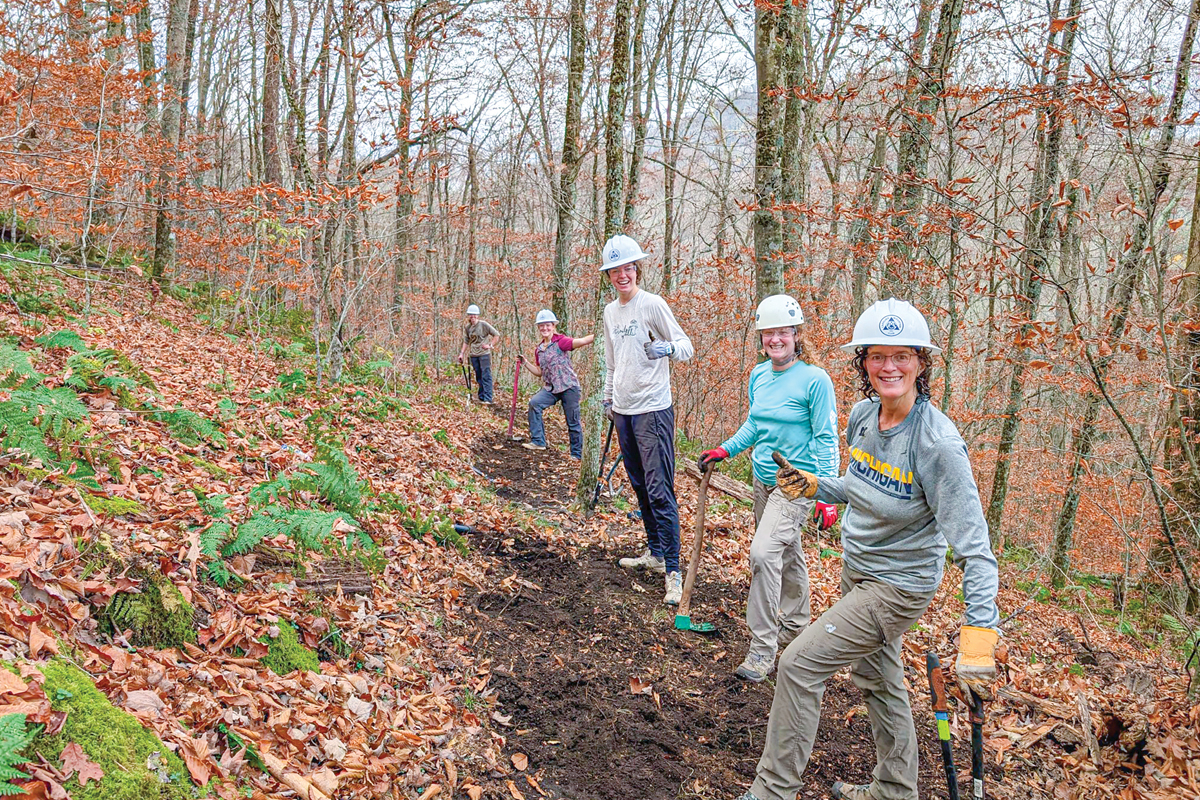Book captures the essence of waterfalls
Flowing water was the primary agent that sculpted the mountains as we know them today. Long before the first Europeans arrived, the ancient Cherokees had developed ceremonials focused on the spiritual power of running water. One of the prized sites for such purification ceremonies was a waterfall. It was there that they could hear a river — which they identified as “the Long Man” — speaking to them in the clear voice of the raging current.
Waterfalls still speak to us today. Along with scenic vistas and fall colors, they are one of the most sought-after natural attractions in the southern mountains. They are dynamic places that seem to encourage contemplation. Whenever I’m conducting a natural history workshop that encounters a waterfall, I ask participants to contemplate why they are so appealing. Invariably, such qualities as constant motion, soothing sound, spiritual tranquility, natural beauty and harmony of sight and sound are mentioned.
I suspect there are at least 25 waterfall guidebooks for this general region: Western North Carolina, East Tennessee, northwestern South Carolina, and north Georgia. Most waterfalls of any significance have been described in some fashion. Do we need another one? The answer is “Yes, we do, if it’s a good one like Jim Parham’s recently published Waterfall Hikes of North Georgia (Milestone Press; 828.488.6601; www.milestonepress.com).
Parham’s book isn’t just good. In regard to basic content — driving and hiking directions, general and specific maps, elevation profiles and trailhead GPS coordinates, and waterfall photos — it’s really good. And in regard to trail-waterfall descriptions, it’s excellent. The prose is crisp and lively. Parham has an eye for details and a gift for describing what he sees in a concise manner. He also has a nice sense of the tensions that exist where the natural world and recent human activities intersect along old rail beds, at former CCC camps, and similar locations.
Parham grew up in Rome, Ga., and graduated from Berry College. He has hiked, paddled, and biked all over the world. He became a guidebook author in 1992. That year the first of his six-volume Off The Beaten Track mountain bike guide series was published by Milestone Press, which he and his wife, Mary Ellen Hammond, own and operate in Swain County.
When asked, Parham advised me that “his favorite hike” is the Raven Cliffs Trail. That section in his book consists of five pages, which contain a general destination map; a specific trail map; a chart (distance, elevation changes, hiking times, etc.); eight photos of falls encountered along three creeks; and a trail-waterfall description from which the following is excerpted:
“Raven Cliffs Falls is at the head of a waterfall-rich drainage area comprising Dodd Creek, Davis Creek, Bear Den Creek, and Little Low Gap Branch. These all flow down out of the Raven Cliffs and Mark Trail Wilderness Areas to form Dukes Creek. On Dodd Creek alone there are at least six waterfalls within a little over three miles. There are three more on Davis Creek, and Dukes Creek has a few as well. It’s a great place to go for a day hike. With numerous campsites along the trail and elsewhere in the area, it can also make a nice overnight excursion ... Once you see it, there’s no mistaking Raven Cliffs Falls. Dropping 170 feet over, under, and through a breach in the rock face, it’s one of a kind. The most easily seen part is also the most dramatic. Far back in a six-foot wide crack, the water makes a 40-foot freefall plunge into a dark green pool. This magical grotto is guarded above and below by rocks and water … Farther up and about halfway to the cliffs is the second falls. Here the river plunges 15 feet, creating a horsetail, then slips another 15 feet down a long slide. You don’t have to hike too much farther to reach the third falls, and at this point many people think they’ve reached Raven Cliffs Falls. It’s an easy mistake to make, since you’re now in an area of cliffs, high above a 30-foot waterfall that careens and then heads steeply up the hill beside it to a cleft in the cliff where the most dramatic part of the waterfall may be seen. The top is still a long way up, hidden between more rock clefts. You can see where people have scaled their way up trying to reach the top of the falls via a series of sketchy-looking, handover-hand, pull-yourself-up trails. Don’t be tempted to try it. The view of the falls really does not get any better than the one from the base of the cleft. Enjoy it, then head back the way you came.”
George Ellison wrote the biographical introductions for the reissues of two Appalachian classics: Horace Kephart’s Our Southern Highlanders and James Mooney’s History, Myths, and Sacred Formulas of the Cherokees. In June 2005, a selection of his Back Then columns was published by The History Press in Charleston as Mountain Passages: Natural and Cultural History of Western North Carolina and the Great Smoky Mountains. Readers can contact him at P.O. Box 1262, Bryson City, N.C., 28713, or at This email address is being protected from spambots. You need JavaScript enabled to view it..
A few wrong turns on the way to paradise
I grabbed my guidebook and pen and wrapped my camera in a plastic grocery bag as it started to rain. Stuffing it all into my backpack, I headed down the ancient looking road, nothing but two narrow ruts overgrown by tall weeds. I wasn’t going back to Waynesville till I found waterfall 50.
I was approaching the last day of my internship, and I had less than four days to complete an online map identifying, describing and providing directions for waterfalls in our widespread Western North Carolina coverage area.
The road lead to a smaller path that headed straight for the creek, and I sloshed upstream in search of the trail on the other side. The path weaved from bank to bank, and it continued to rain.
I waded up the creek around a bend, and there it was — a 60-foot beauty known simply as the Upper Waterfall on Sols Creek.
Two months ago, with Kevin Adams’ waterfall map spread out on a Rubbermaid tub filled with back newspaper issues in the office, some coworkers and I decided which waterfalls to include in the map.
The list of potentials was daunting. More than 270 waterfalls fell in our four-county coverage area and neighboring parts of Transylvania County. With so little time, seeing them all would be impossible.
Since we don’t distribute papers in Transylvania, most of the county’s beautiful falls got axed from the list first, followed by those that involved bushwhacking or hiking more than two miles to access.
After having lived in Charlotte for 10 years and being the descendent of Midwestern farmers and Lutheran pastors, I didn’t want to do anything that would test my limited high-country outdoors experience beyond its limits.
With friends headed on vacations or tied up with summer jobs, my pool of hiking partners dwindled. And although I was afraid to venture out on my own, I had to reconcile myself to the fear of getting lost because if I didn’t get started soon on my own, I’d never finish.
About a month and a half later — and about 30 waterfalls into my journey — I set out to find Yellowstone Falls in Graveyard Fields off the Blue Ridge Parkway. My directions, in short, said to find a trail at the back of a couple of campsites and follow a path to the river.
I never found the path to the river. Instead I found a path that at first seemed like the right one, but eventually dwindled to nothing more than trodden grass, and beyond that a thick maze of tangled, impenetrable rhododendron bushes. When I tried to find my way back, I reached another dead end at a blackberry briar.
Had I not just come this way? A sinking feeling in the bottom of my stomach overtook me. I was lost.
I retraced my steps back and forth a few more times, then started to rip out pages of my reporter’s notebook, leaving them on the tree branches I passed.
Making no progress, I sat down at a small campfire ring. Small grassy footpaths like the one I came in on spread out like a spiderweb from where I sat. I dug my phone out of my backpack and figured the worst thing I could do was panic. Thank God for cell phone towers — I had one bar.
I called my editor, Becky Johnson. She studied a trail map of the area on the other line, but I still couldn’t determine which direction was out. She gave me the number for the Forest Service, and I called them next.
A few hours later, I heard them yelling my name from the other side of a blackberry briar a couple hundred feet away. They stomped a path through the blackberry thicket. I was getting out and going home!
After loafing around my apartment the next Saturday, convincing myself I had better things to do than hike, I finally found the gumption to face Graveyard Fields again.
I didn’t try to find Yellowstone Falls but had to get Upper Falls crossed off the list. I found a few hikers eating blueberries and followed them to the waterfall.
Even having to face what scarred me most didn’t dull the obsession with the Western North Carolina landscape that brought me to a summer internship at The Smoky Mountain News.
I knew that if there was paradise on Earth, it had to be at the base of some of the region’s waterfalls. And I wanted to see them all, but I now know that’s impossible.
So as I pack my boxes and prepare for my senior year at UNC-Chapel Hill, I’m left with the same sentiment most reporters feel when the deadline approaches for their big stories: I wish I had more time.
For now, 50 waterfalls will have to do.
— Elizabeth Jensen
The allure of falling water
Although most people are drawn to waterfalls, many pause before they can articulate why. For some, it’s the sound of the water tumbling over the rocks. For others, it’s the sheer beauty or tranquility.
“Everybody loves them, but nobody can tell you why,” said Kevin Adams, author of North Carolina Waterfalls, A Hiking and Photography Guide. “We’re just mesmerized by them.”
• View the interactive map of 50 selected waterfalls in WNC
• See also: A few wrong turns on the way to paradise
Part of Adams’ love for waterfalls stems from his passion for photography.
Sometimes he’ll take ladders and ropes or swim with his camera to get the shot he wants. But he’s careful and has never hurt himself at a waterfall.
“I respect them. I know how dangerous they are,” Adams said. “I have a wife I love very much that I want to come home to.”
For a quarter of a century, Adams had been trying to shoot a picture of a moonbow, a rainbow caused by the light of the moon instead of the sun. And last winter, he got the shot after standing for 45 minutes in the freezing spray of Rainbow Falls on the Horsepasture River.
With eight inches of snow on the ground and temperatures dipping to 15 degrees, Adams’ camera, clothes and tripod were covered with a thin layer of ice. But he didn’t notice — not until he started heading back to his car.
Whatever the power of attraction may be, the Jackson County Travel and Tourism Authority knows the ability waterfalls have to draw visitors to the area.
“We understand that waterfalls are one of our greatest resources and attractions,” said Julie Spiro, tourism director in Jackson County.
Spiro has capitalized on being at the heart of waterfall country by creating a map of 19 waterfalls in or near Jackson County. They go through 50,000 of the brochures every year.
“We hand them out all the time,” Spiro said. “It is the most popular product we put out. It’s a wonderful relaxing thing to do that’s still free.”
Spiro has been to all the waterfalls on the map so she can give accurate instructions to visitors. If a tourist can only see one waterfall, she recommends Whitewater Falls, which at 411 feet is the highest waterfall on the East Coast.
“This is the one that will make the biggest impact on their memory,” she said.
Adams also has had great success with his guidebook and photography, so much so that he was able to quit his carpentry job about five years ago and follow his passion fulltime.
His parents always talked about writing a guidebook on North Carolina waterfalls after seeing Lineville, Whitewater and Looking Glass falls on vacation. But it wasn’t until the early 1990s that Adams took on the task.
In 1992, Adams made a cold call to the John F. Blair publishing house in Winston-Salem to see if the guidebook was a feasible idea. He got an answer he wasn’t expecting.
The publisher just happened to be looking for someone to write a book on waterfalls and invited Adams in for an interview. He landed the job. It took Adams a year to do the research and six months to write before the book went to press in 1994.
The waterfall gurus
Adams has seen more than 800 waterfalls — likely more than anyone else alive. But he remains humble about his expertise and willing to share his knowledge. When someone calls him a “guru” or refers to his book as a “waterfall Bible,” he chuckles.
“I realize I know more about North Carolina waterfalls than anyone else on the planet, but I don’t think of it that way,” he said. “Nobody will ever come close to seeing all of them.”
Like Adams, visiting waterfalls is a part of both Jordan Mitchell’s family heritage and publishing success. But Mitchell has gone the online route, posting his information about waterfalls online at northcarolinawaterfalls.info.
The website draws 150,000 unique visitors every month during the summer.
“I have this dueling interest between the outdoors and computers,” he said. “This allows them to come together.”
Between his fulltime job as a software developer and as a new father, Mitchell only makes it to waterfalls a few times a month — still more than most people do in a year, but not enough by Mitchell’s standards.
His daughter, Harper, was only 5 months old when he took her to her first waterfall — also one of the first waterfalls he had ever been to, Douglas Falls in Buncombe County. At the base of the falls, the chronically fussy baby simply stared at the water in silence.
“She was more thrilled than I could imagine she’d be,” he said. “She was mesmerized.”
Why the rush?
Bryson City writer and naturalist George Ellison said he thinks part of the reason people are fascinated with waterfalls is that they activate all five senses, likening the experience of standing at the base of a waterfall to walking into a bakery.
But there may be an even stronger scientific reason behind people’s fascination with waterfalls and for the euphoric feeling many have at the base of a waterfall.
Rushing water in waterfalls releases negatively charged ions. Once they’re breathed in and begin to circulate in the blood, negative ions trigger biochemical reactions that increase the production of a neurotransmitter called serotonin, which can reduce stress, lift the mood and increase energy, according to “Negative Ions Create Positive Vibes” written by WebMD reporter Denise Mann and reviewed by Dr. Brunilda Nazario. They also increase the amount of oxygen that gets to the brain.
“The air circulating in the mountains and the beach is said to contain tens of thousands of negative ions — much more than the average home or office building, which contains dozens or hundreds, and many register a flat zero,” Mann wrote.
But some scientists remain skeptical of the claim. And many waterfall goers feel the escape the scenery offers is enough to lift their spirits.
“I enjoy taking the day off from work and getting away from it all,” said Tom Mendenhall after hiking with his brother and friend to reach Wardens Falls in Panthertown earlier this month.
Wayne Joyce, Mendenhall’s friend with a vacation home in Cashiers, said he plans most of his hikes around waterfalls, often eating lunch at the base. Wardens Falls is one of his favorites.
“We hiked five miles to get here so we must like it,” he said.
That same day, Dawn Lavers came to Wardens Falls with her friends and family, who recently moved to Lake Toxaway from Florida.
“We only come when we really don’t have to be anywhere,” she said. “You don’t ever want to be rushed to leave.”
Lavers said that there’s beauty in every waterfall, but that each one is beautiful for a different reason. Some are powerful and dangerous; whereas, others are tranquil and secluded or make for great swimming holes.
The beauty of the region’s waterfalls was enough to lure Rich Stevenson, founder and developer of ncwaterfalls.com, to move to the mountains from Raleigh.
While he was working at Federal Express, Stevenson visited friends in the mountains who took him on a tour of the chain of falls on the Horsepasture River, including Turtleback and Rainbow Falls.
“I used to be a big beach person, but after that I kept coming back to the mountains,” he said.
Stevenson quit the two jobs he had in the Triangle and moved to Western North Carolina. Since then, he estimates he’s seen 400 to 500 falls. Some of the falls he heard about from locals he worked with at his manufacturing job in Candler — locals who’ve spent their entire lives exploring and fly-fishing in the backcountry.
“Once they realize I wasn’t a city wacko, they’ve turned me on to some places,” he said.
In 1999, Stevenson began posting his waterfall finds online. And in 2001, he launched ncwaterfalls.com, one of the most comprehensive online indexes of North Carolina waterfalls.
“At first I thought I was the only fool out there looking for waterfalls,” Stevenson said.
But Stevenson was wrong. The site has grown to include about 280 waterfalls and receives between 1,000 and 2,000 unique visitors a day.
Waterfall hunters
Stevenson soon learned there was a circle of waterfall hunters like himself, those who will strike out along a creek coursing over steep terrain, sometimes bushwhacking and sometimes wading their way down the mountain hoping to discover a previously unknown waterfall.
Stevenson’s swing shift job keeps him from exploring new falls as often as he’d like. Usually, his friend Bernie Boyer, a retired man in his seventies, will study topographic maps, discover a new falls and take Stevenson to it on his next trip.
But sometimes Stevenson finds time to hop in a creek bed and head upstream in hopes of discovering something himself.
“Usually the first thing is that you hear the sound,” he said. “You feel your heart pounding a little bit. There’s a real excitement knowing there’s something around the corner.”
But when it comes to the relatively undiscovered falls, Stevenson and Adams use discretion before making directions available to the public.
Although some of sights they discover are spectacular, the environment at the base of the falls is fragile, covered in rare plant and animal species. A plethora of hikers would destroy the falls’ unique inhabitants.
“You go there and you see that it looks like nobody’s been there for 100 years,” Stevenson said.
Some of the most unique species located at waterfalls are rare ferns, typically found only in the tropics. Because these species of ferns in North Carolina don’t grow to their adult form, they don’t look like a typical fern. They are usually only a small leaf.
The species grow in low light and moist, cool environments, the conditions found behind a waterfall.
“You have a small area with a lot of diversity in a microclimate,” said Anya E. Hinkle, Highlands Biological Station associate director. “Even if it’s hot, a waterfall really cools things off quickly.”
Figuring out how the species took root at North Carolina waterfalls can solve mysteries related to plant migration or provide geographical clues about how the areas were once located closer together before the continents shifted to their present positions.
Naturalist George Ellison often leads flora tours to waterfalls to view the unique plants. He’s seen many of the area’s falls, but some of his fondest memories come from Little Creek Falls, a small-flow, nearly vertical cascade in a lesser known area of the Great Smoky National Park outside Bryson City.
He would take his children to the falls decades ago before the public property in front park entrance came under the ownership of a trout farm.
“People are naturally attracted to the larger ones like Whitewater Falls,” Ellison said. “But those aren’t the ones that mean the most to people around here.”
It’s one of those smaller waterfalls that Kevin Adams holds a particular fondness for. Although he doesn’t usually name the falls he discovers, he named one in the Nantahala National Forest Loretta Falls after his mom.
“She instilled the love of waterfalls in me,” he said. “I knew she would absolutely love it.”
The falls is the tall freefall of a small creek. At the base of the falls, there’s no pool, only thick moss and ferns and some tall hemlock trees.
“It’s a really nice feeling to walk up to a waterfall that you’ve never seen before,” Adams said. “I got to tell you that’s one hell of a feeling, standing there in front of it.”






















